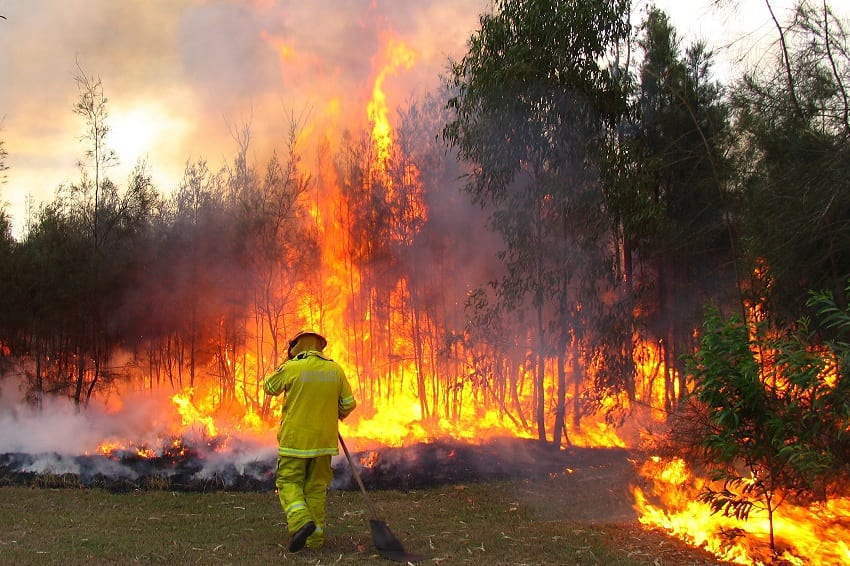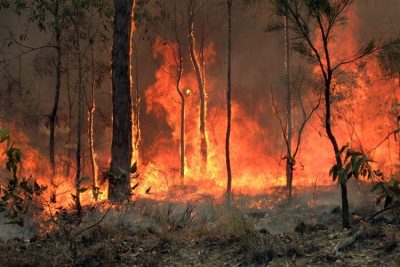Australian Bushfires: Deadly Yet an Inextricable Part of the Australian Ecosystem
Share

Bushfires in Australia. (bert knottenbeld / Flickr)
In Australia, bushfires occur almost every other day and continue with a rapid movement across any terrain. Even though fires may be considered more like a bane than a boon, Australia’s ecosystem has adapted to these bushfires and, in fact, it forms an integral part of its ecosystem. Some bushfires are naturally occurring while some are man-made. Although we have no control over the natural fires that occur, the human population of the region can implement certain safety measures to reduce the damage caused by these bushfires.
What causes the bushfires?
Bushfires spread quite rapidly compared to normal fire, however, it is not as fast as the outbreak of a deadly grassfire. The reason why Bushfires are such a common occurrence in Australia may be attributed to the presence of elements like fallen leaves, barks, and other dry material, that are easily combustible. The weather conditions in Australia are favourable for bushfires, as the scorching heat maintains a constant state of drought in parts of the continent. These factors coupled with strong winds make it just the right combination for the fires to start. While most of the causes are from activities conducted by humans, sometimes the widespread devastation caused by bushfires is triggered by lightning. Emission of greenhouse gases, sparks from power lines, and global warming caused by humans, are other contributing factors to the increasing bushfires in the Australian subcontinent.
Fire ecology of Australia
The Department of Biodiversity, Conservation and Attractions of Western Australia states “Many plants hold their seeds in thick woody fruits or capsules, where they are protected from fire. The heat of the fire assists in opening the capsules, allowing the seeds to be shed within a few days. When the seeds fall to the ground they land in the ash bed, which is high in the nutrients needed for strong seedling growth.”
Bushfires, over the years, have actually become an essential part of the Australian ecosystem. Many of the indigenous flora has evolved to not only survive the flames, but also to benefit from them. The plants have adapted themselves to survive by sporting thick barks, leaf sheaths, below-ground roots, and underground stems. One interesting adaptation is above-ground re-sprouting that uses epicormic buds for reproduction, in the event of a fire. These buds are located below the bark thus ensuring their safety in case of a bushfire. This unique adaptation of fire-activated seeds has helped increase productivity in farms and other forest areas. Once the foliage has been cleared by bushfires, the sunlight falls directly on the soil. This improves soil quality and facilitates improved regeneration of the plants. These plants are termed as “Pyrophytic plants”.

A panoramic photo of a wildlife refuge recovering from forest fire over a period of two years. (U.S. Fish and Wildlife Service Southeast Region)
Fires used by birds and humans
The Australian Aboriginal Lore is a species of bird that has set a precedent for both humans and other birds to draw inspiration. In order to capture their prey, the Australian Aboriginal lore has been using fire for centuries to hunt their prey, following which other species of birds such as the Australian Raptor have also used fire as a means of hunting. Humans have also followed suit and made changes to their ways of farming and clearing out the lands for fresh crops.
Australian Aborigines, or what we call indigenous Australians, have made progress in using pyro-techniques more effectively by understanding how the birds use it to hunt their prey. It is considered a tradition in the indigenous tribe and has been a part of their culture. Some tribes have discontinued the use of pyro-techniques owing to the lack of control they have over the fire. The technique called fire-stick farming, dating back to over 120,000 years ago, had also evolved as a pyro-technique for farming. Though this technique was discontinued by most, officials in Australia are considering using these aboriginal farming techniques to control the fires growing frequency of bushfires, and improve the current condition of land management employed by the modern-day farmers.
Effects of the fires
The air quality of a region is quite a critical factor that governs the over-all health of the populace. The forest fires have ensured that the air quality in Australia is sub-par, which is especially concerning for big cities, like Sydney, that suffer from air quality more than 20 times worse than desirable. Consequently, people suffer from intense respiratory issues and other ailments making their daily life difficult.
A technique called ‘back burning’ has been used to get rid of any vegetation that may serve as fuel for future fires caused by man-made or natural factors. This involves the burning of bushes in a controlled manner which can ideally be put out at any time. Even though the concept was to have controlled bushfire outbreaks, some have spiralled out of control and claimed lives and damaged property.
Among other things, loss of livestock is very common during bushfires.
Bushfires changing the climate?
With the increasing intensity and number of bushfires, it has been established by the Bureau of Meteorology in Victoria that the phenomenon is generating its own weather conditions. This weather incites thunder and lightning which are generating more bushfires as time progresses. The clouds that are forming due to the bushfires are called pyro-cumulonimbus clouds and are also generating smoke-filled air which degrades the general air quality. Due to the sheer intensity of the bushfires and strong winds coupled with the Pyro-cumulonimbus clouds, there have been instances where a fire vortex or fire-tornado is created and causes severe damage to the areas in its path.
The fires are causing so much devastation across Australia at the moment that people are constantly evacuating their homes and taking shelter in public spaces such as beaches and parks that have a wide-open space and are less prone to bushfires. While the bushfires generate their own weather, they are also making the sky look red. People have been asked to be prepared for the worst.
Loss of habitat
While us humans can escape and evacuate promptly when danger strikes, most animals may not be able to do the same and end up getting trapped in the blaze.
Koalas are an integral part of the Australian wildlife and have recently been under threat because of the increasing bushfires occurring in and around Sydney. In one such case, a koala bear had been wandering and found itself trapped in a bushfire. Luckily a woman had spotted that koala bear from far away, the woman rescued the koala from the blaze by covering it with her own shirt. However, unable to recover from the burns the koala later succumbed to burn injuries.
What we can take from this is that humans are not the only ones being affected by the bushfires in Australia. Putting up effective countermeasures will not only help humans but also animals who are extremely helpless in such conditions. While Koalas remain an integral part of Australia’s ecosystem, they are under a massive threat. The Australian Koala Foundation places the death toll of the animal at a thousand and counting. The bushfires have destroyed more than eighty percent of their habitat and have rendered the remaining “functionally extinct” since the koalas only consume parts of the eucalyptus trees, which have been burnt down in the bushfires. Roughly only 43,000 koalas are still left in the wild, and measures need to be taken to safeguard the ecosystem successfully.
Countermeasures for the bushfires
With almost 4 million hectares of land consumed by bushfires and countless lives lost, the Australian Government has made plans to counter the bushfires by deploying naval and air forces to help people evacuate and at the same time assist the firefighters to mitigate the fires. To avoid more sparking of bushfires, certain areas have been cut off from any form of electricity. Scott Morrison, the Australian Prime Minister has pledged to reduce the greenhouse gas emissions down by 26-28% which if followed, will reduce bushfires drastically due to reduced heat conditions. While all that may seem like a plan for the future, the areas that have already been affected are getting support from the government in terms of money, food, fuel, and water. Most importantly, people are being evacuated in an orderly manner to help them escape the rampaging bushfires.
Want to share photos of the Australian bushfire? Email your photos to [email protected]
Enjoyed this article? Also, check out “Forest Fire: Birds Deliberately Setting Forests on Fire to Flush Out Prey“.
Fact Analysis:
STSTW Media strives to deliver accurate information through careful research. However, things can go wrong. If you find the above article inaccurate or biased, please let us know at [email protected]













